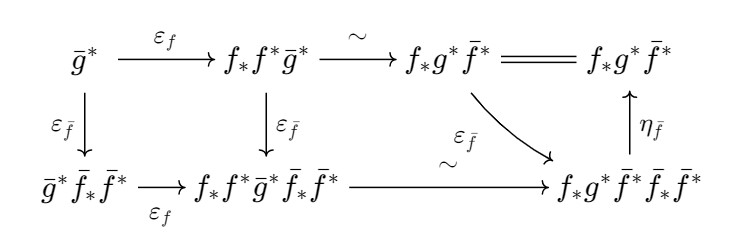Given a (not necessarily Cartesian) square of spaces $$\require{AMScd}\begin{CD} X @>g>> \overline{X} \\ @VVfV @VV\overline{f}V \\ Y @>\overline{g}>> \overline{Y} \end{CD}$$ does the following $$\require{AMScd} \begin{CD} \overline{g}^* @>\epsilon_f>> f_*f^*\overline{g}^* @= f_*g^*\overline{f}^* \\ @V\epsilon_{\overline{f}}VV @. @A\eta_{\overline{f}}AA \\ \overline{g}^*\overline{f}_*\overline{f}^* @>\epsilon_f>> f_*f^* \overline{g}^*\overline{f}_*\overline{f}^* @= f_*g^*\overline{f}^*\overline{f}_*\overline{f}^* \end{CD} $$ commute?
By space I mean either scheme/stack/prestack and the second diagram occurs in $\text{QCoh}(-)$, or a more restrictive class of spaces like Artin stacks and the diagram occurs in the category of $\ell$-adic sheaves, or some sheaf theory with the six functors.
The right-up composition $\overline{g}^*\overline{f}^*\to f_*g^*$ is called the Beck-Chevalley composition, and a version of this question appears in 4.1.1 of "Ambidexterity" by Haine, but it has additional assumptions of "ambidexterity" on the maps, which one might hope could be dropped for the above question.

